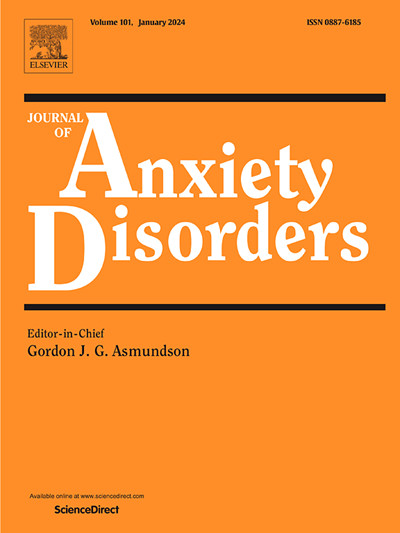Sleep disturbances predict nine-year panic disorder chronicity: The sleep-panic nexus theory with machine learning insights
IF 4.5
2区 医学
Q1 PSYCHIATRY
引用次数: 0
Abstract
Background
Panic disorder (PD) is a chronic and impairing anxiety disorder. Individuals with more sleep disturbances might be predisposed to nine-year PD chronicity. However, linearity assumptions, small predictor sets, and analytic and design limitations have hindered optimal identification of which sleep disturbance variables are distal risk factors for PD chronicity. We thus used machine learning (ML) to predict nine-year PD chronicity using high-dimensional data.
Method
Community-dwelling adults (N = 1054) completed clinical interviews, self-reports, and seven-day sleep actigraphy at Wave 1 (W1) and the same clinical interview at Wave 2 (W2) nine years later. The baseline data comprised 43 actigraphy, self-reported sleep disturbances, clinical, and demographic variables. Seven ML models were examined. Gradient boosting machine (GBM) was the best-performing algorithm. PD chronicity was defined as the presence of a PD diagnosis at both W1 and W2.
Results
The GBM accurately predicted PD chronicity (area under the receiver operating characteristic curve [AUC] =.764). Shapley additive explanation analysis showed that the top W1 predictors of PD chronicity were comorbid major depressive disorder, low healthcare utilization, sleep medication use, lengthier wake after sleep onset, and sleep-wake circadian disruptions based on actigraphy and self-reports. Lower household income and younger age were also top predictors. Additionally, the final multivariate model was well-calibrated.
Conclusions
As proposed in our sleep-panic nexus theory, actigraphy and subjective sleep disturbances have essential prognostic value in predicting long-term PD chronicity. Harnessing ML facilitates accurate prediction by identifying complex, nonlinear relations across high-dimensional datasets, possibly improving prevention and treatment tailoring.
睡眠障碍预测9年的慢性恐慌症:睡眠-恐慌联系理论与机器学习的见解
背景:惊恐障碍(PD)是一种慢性、损害性的焦虑障碍。睡眠障碍较多的人可能更容易患上长达9年的PD慢性疾病。然而,线性假设、小预测集以及分析和设计的局限性阻碍了最佳识别哪些睡眠障碍变量是PD慢性的远端危险因素。因此,我们使用机器学习(ML)来使用高维数据预测9年PD慢性性。方法居住在社区的成年人(N = 1054)在第一阶段(W1)完成临床访谈、自我报告和7天睡眠活动仪,9年后在第二阶段(W2)完成相同的临床访谈。基线数据包括43项活动记录、自我报告的睡眠障碍、临床和人口统计学变量。检测7个ML模型。梯度增强机(GBM)是性能最好的算法。PD慢性定义为在W1和W2均有PD诊断。结果GBM能准确预测PD的慢性性(受试者工作特征曲线下面积[AUC] =.764)。Shapley加性解释分析显示,PD慢性的前W1预测因子为共病性抑郁症、低医疗保健利用率、睡眠药物使用、睡眠开始后清醒时间延长以及基于活动图和自我报告的睡眠-觉醒昼夜节律中断。较低的家庭收入和较年轻的年龄也是主要的预测因素。此外,最终的多变量模型得到了很好的校准。结论根据睡眠-恐慌联系理论,活动描记和主观睡眠障碍在预测PD的长期慢性方面具有重要的预后价值。利用机器学习通过识别高维数据集之间复杂的非线性关系来促进准确的预测,可能会改善预防和治疗的定制。
本文章由计算机程序翻译,如有差异,请以英文原文为准。
求助全文
约1分钟内获得全文
求助全文
来源期刊

Journal of Anxiety Disorders
Multiple-
CiteScore
16.60
自引率
2.90%
发文量
95
期刊介绍:
The Journal of Anxiety Disorders is an interdisciplinary journal that publishes research papers on all aspects of anxiety disorders for individuals of all age groups, including children, adolescents, adults, and the elderly. Manuscripts that focus on disorders previously classified as anxiety disorders such as obsessive-compulsive disorder and posttraumatic stress disorder, as well as the new category of illness anxiety disorder, are also within the scope of the journal. The research areas of focus include traditional, behavioral, cognitive, and biological assessment; diagnosis and classification; psychosocial and psychopharmacological treatment; genetics; epidemiology; and prevention. The journal welcomes theoretical and review articles that significantly contribute to current knowledge in the field. It is abstracted and indexed in various databases such as Elsevier, BIOBASE, PubMed/Medline, PsycINFO, BIOSIS Citation Index, BRS Data, Current Contents - Social & Behavioral Sciences, Pascal Francis, Scopus, and Google Scholar.
 求助内容:
求助内容: 应助结果提醒方式:
应助结果提醒方式:


